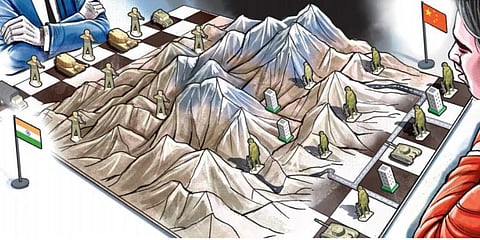

NEW DELHI: the 15th round of Corps Commander level talks between India and China will be held with an aim to resolve the standoff at the areas in the Eastern Ladakh on March 11, said sources in the defence establishment.
Sources in the Defence Establishment confirmed, “India and China have mutually decided to hold the 15th round of Corps Commander level talks at the Indian side of Chushul Moldo Meeting Point on 11 March 2022.”
The Indian side will be headed by Lieutenant General Anindya Sengupta who took over as the General Officer Commanding of Leh-based Fire and Fury Corps in January. The Chinese side will be led by South Xinjiang Military District Commander Major General Yang Lin. This level of engagement between the two countries is also known as the Senior Highest Military Commander Level (SHMCL) talks.
“Both sides will now focus on achieving resolution on the balanced friction areas. Recent statements by both sides to find a mutually acceptable solution have been encouraging and positive in nature.” the sources added.
There has been a state of stalemate since the 13 round of the Corps Commander level talks held on October 10, 2021. Things on the ground did not change even after the 14th Round of SHMCL talks on 12 January 22 at the Chushul-Moldo meeting point, on the Chinese side.
India and China have been holding talks on the Line of Actual Control in the Eastern Ladakh area to resolve the standoff and 14 rounds have been held so far. “The talks have resulted in the resolution of the North & South Bank of Pangong Tso (North and South Banks), Galwan (PP 14) and Gogra (PP 17A) areas.”
The talks held till now have resulted in the resolution of the North and South Bank of Pangong Tso, Galwan and Gogra Hot Spring areas.
There have been endeavors to disengage the Indian Army and the PLA troops from Hot Springs (Patrolling Point 15). The standoff persists also at Depsang Y-Junction and Demchok. The Depsang standoff has resulted in obstruction of Indian troop movement to the traditional Patrolling Points (PP) PP 10, PP11, PP 11A, PP12 and PP13. A few Tents have been pitched by the Chinese on the Indian side in Demchok and have disagreed to move back.
The agenda of the talks remains disengagement at standoffs in Hot Springs, Depsang and Demchok.
Army Chief Naravane had earlier said that while there has been partial disengagement, the Chief made it clear that "the threat has by no means reduced.”
Making a statement during a Press Conference on March 7 in Beijing, China’s Foreign Minister and State Councillor Wang Yi said that the relations between the two countries “have encountered some setbacks in recent years, which do not serve the fundamental interests of the two countries and the two peoples.”
“As we have seen, some forces have always sought to stoke tension between China and India and division between regions. Their attempts have put more and more thoughtful people in reflection and on alert.”, said Wang Yi.
As reported first by the TNIE, the eastern Ladakh border standoff between the Indian and Chinese militaries erupted on May 5, 2020, following a violent clash in the Pangong lake areas. Both sides gradually enhanced their deployment by rushing in tens of thousands of soldiers as well as heavy weaponry.
Each side currently has around 50,000 to 60,000 troops along the Line of Actual Control (LAC) in the sensitive sector.